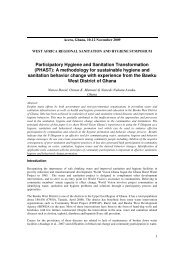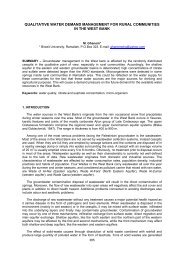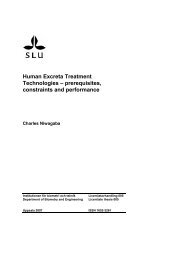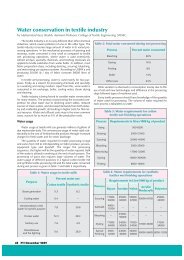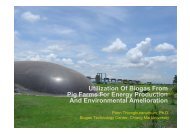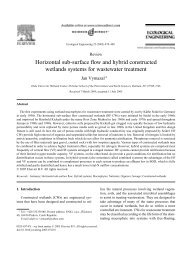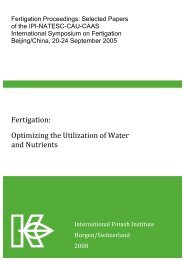The Incinerator Guidebook: A Practical Guide for Selecting ... - SSWM
The Incinerator Guidebook: A Practical Guide for Selecting ... - SSWM
The Incinerator Guidebook: A Practical Guide for Selecting ... - SSWM
You also want an ePaper? Increase the reach of your titles
YUMPU automatically turns print PDFs into web optimized ePapers that Google loves.
V. Installation<br />
Installation of incinerators should include site preparation, equipment installation and<br />
commissioning, service and operating instructions provided by the manufacturer, assured<br />
manufacturer support, metal works (fuel tank, filter and supply lines, electrical power supply, etc.),<br />
and civil works (foundations, pits, water supply and run off <strong>for</strong> rinsing reusable recipients). Security<br />
and the safety of the installation need to be given great importance.<br />
<strong>The</strong> following sections summarize civil engineering requirements applicable to permanent HCWM<br />
disposal sites.<br />
Site selection<br />
Certain measures need to be taken to protect the local communities from the possible hazards of<br />
medical waste. <strong>Incinerator</strong>s should never be installed in areas where crops are grown; particles from<br />
the smoke emitted by the incinerators can settle on crops, making them highly toxic. If <strong>for</strong> whatever<br />
reason incinerators have been installed near cultivated land, the incinerator should be operated only<br />
when the wind is blowing away from the crops.<br />
<strong>The</strong> selection of an appropriate location to install an incinerator is of paramount importance. Key<br />
factors to be taken into consideration are:<br />
� <strong>The</strong> location should be at least 30 meters away from the closest occupied or inhabited<br />
building.<br />
� <strong>The</strong> prevailing winds at the location should blow in a direction away from occupied<br />
buildings.<br />
� <strong>The</strong>re should be no regular public passage within immediate proximity of the<br />
incinerator.<br />
� <strong>The</strong>re should be no horticulture or leaf crops within 300 meters of the incinerator in the<br />
direction of the prevailing winds.<br />
� <strong>The</strong> bottom of the ash pit should be above the maximum level of the water table.<br />
� <strong>The</strong> location should be secure and free from risk of vandalism or theft.<br />
� <strong>The</strong> location should permit construction of a facility to house the incinerator (unless<br />
designed <strong>for</strong> external use) and store the waste awaiting disposal. <strong>The</strong> site should also<br />
include an ash pit and placenta pit (as appropriate).<br />
Incineration by itself is not a solution <strong>for</strong> medical waste disposal. A complete, self-contained waste<br />
management system needs to be put in place. This includes an incinerator; a secure waste storage<br />
facility; a fuel store; an area <strong>for</strong> glass and sharps deposit; a protected ash disposal pit; a lockable<br />
secure enclosure <strong>for</strong> the incinerator; a facility to store the tools, protective clothing, and operator<br />
records; and a washing area with waste water runoff.<br />
Protective enclosure<br />
<strong>Incinerator</strong>s should be installed in a protective enclosure or suitably ventilated building to prevent<br />
access by unauthorized persons and to protect the incineration equipment. A protective enclosure or<br />
building should ensure that:<br />
� <strong>The</strong> incinerator and other materials stored inside are protected from rain and UV<br />
radiation from direct sunlight.<br />
� <strong>The</strong> incinerator is well ventilated and the stack emissions are clear of the building or<br />
enclosure so that the operator is not exposed to fumes when the incinerator is in use.<br />
� <strong>The</strong> enclosure is robust and corrosion resistant, and its design-life is at least equivalent<br />
to the expected life of the incinerator.<br />
� <strong>The</strong> enclosure or building can be securely locked against unauthorized entry.<br />
17




